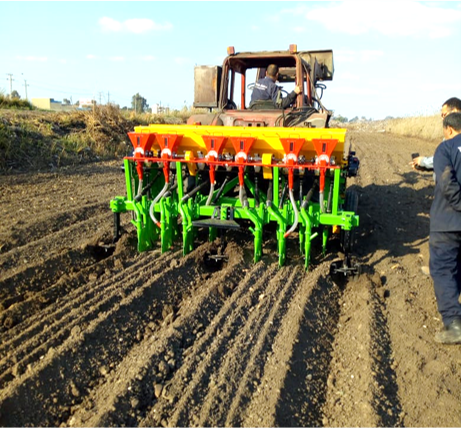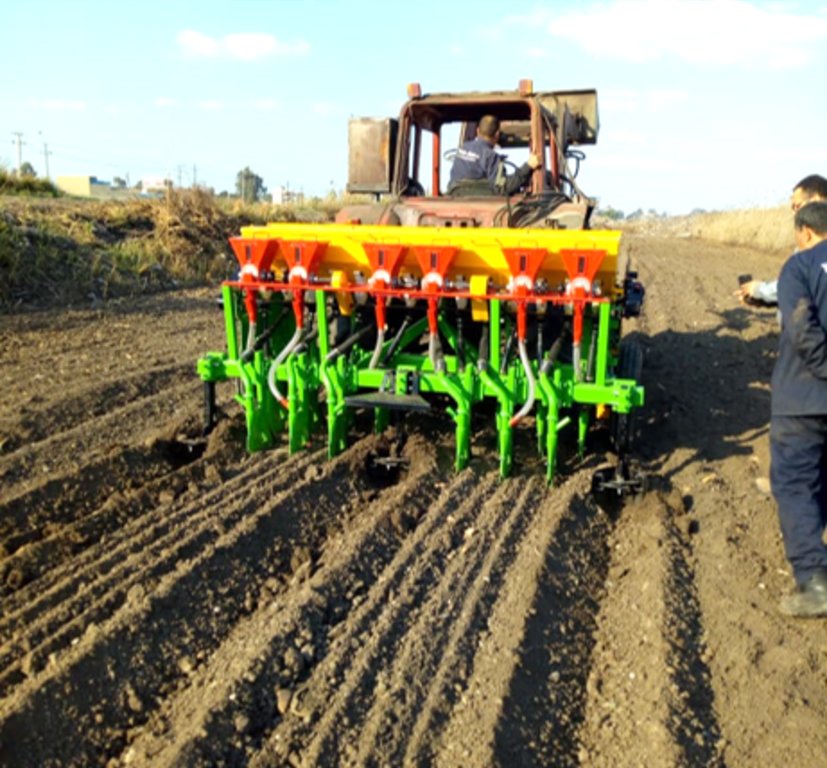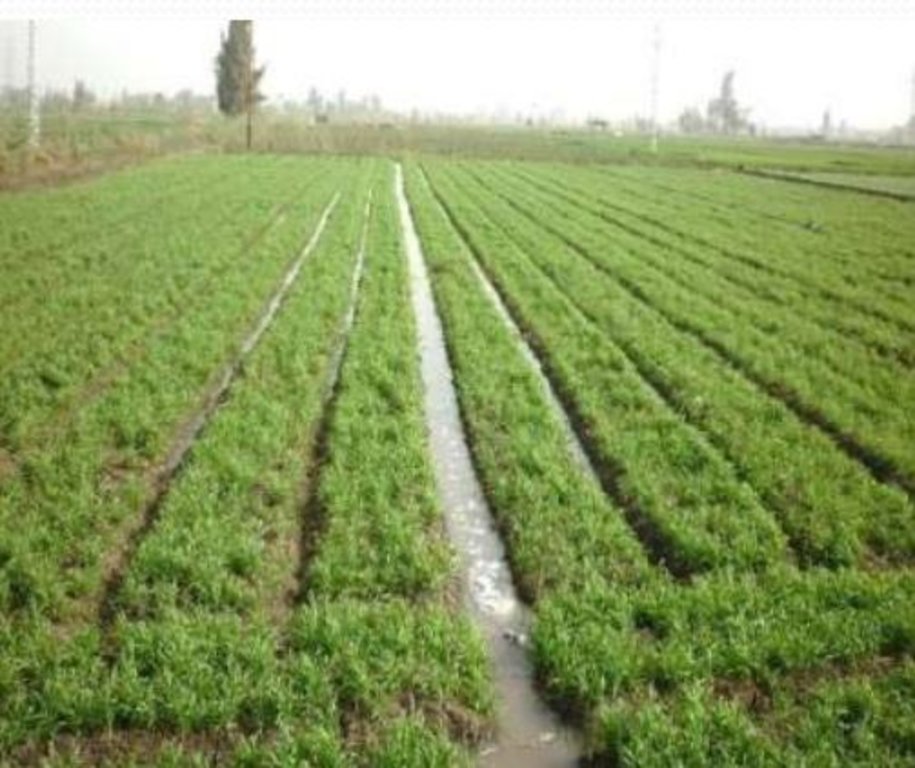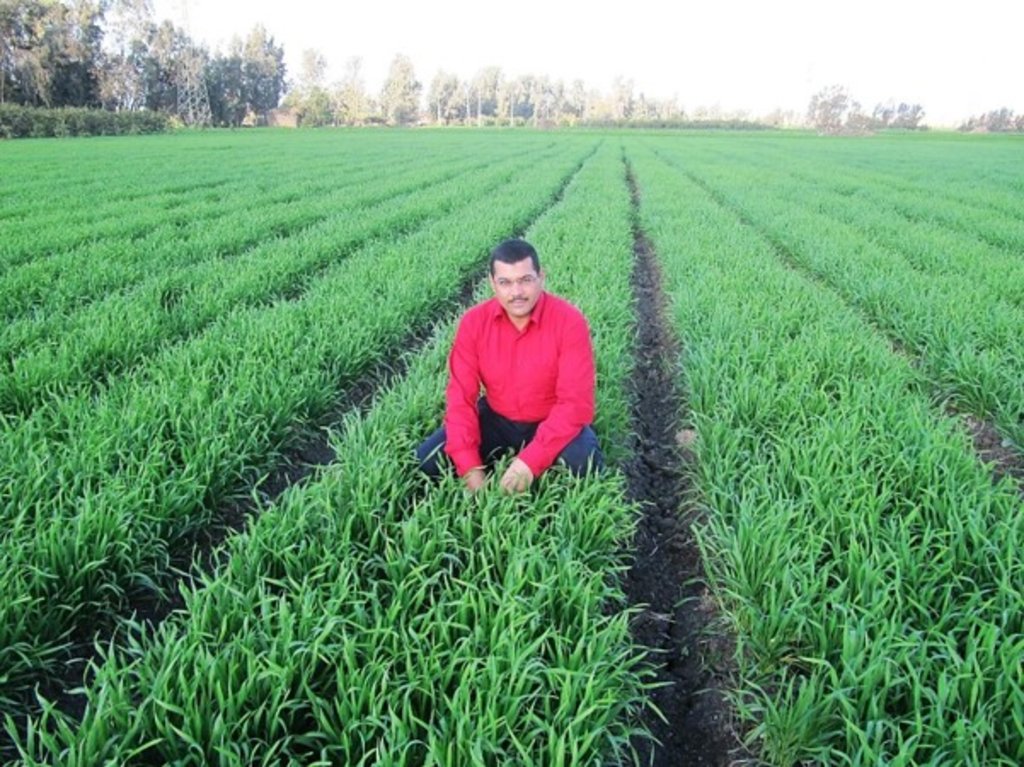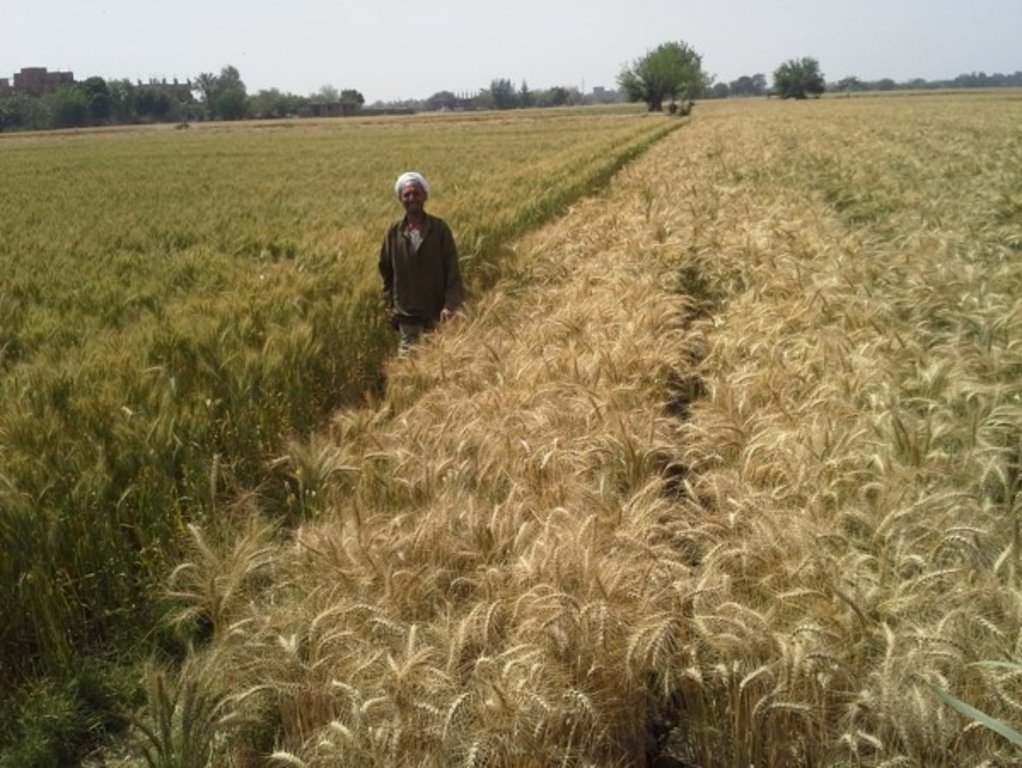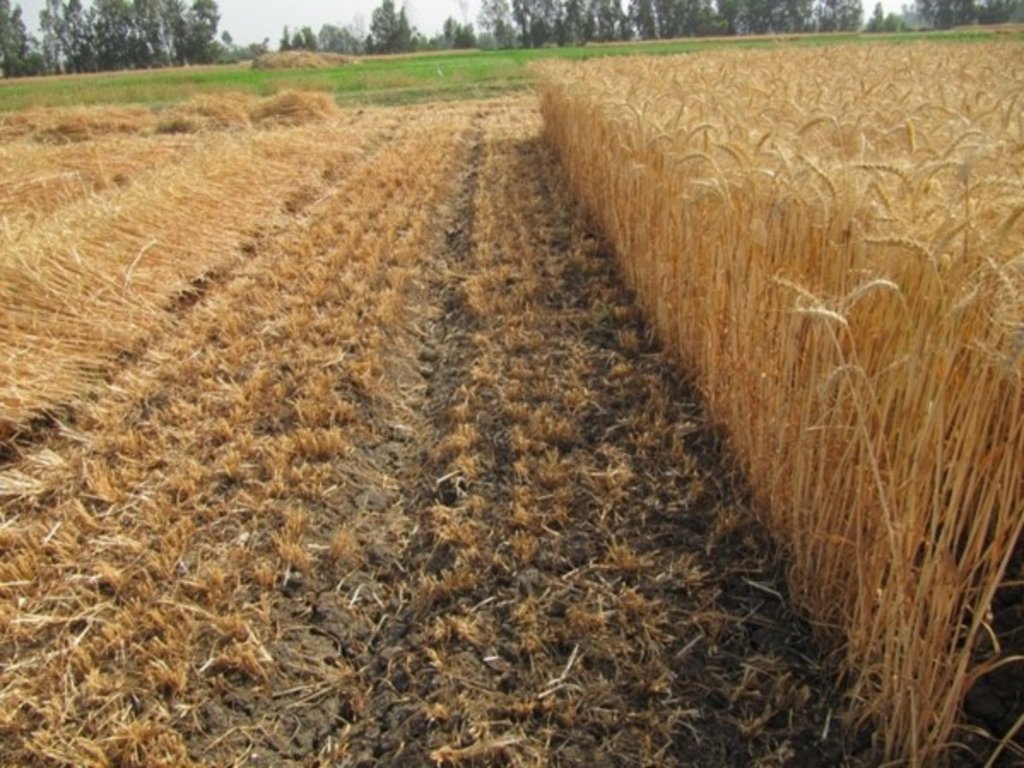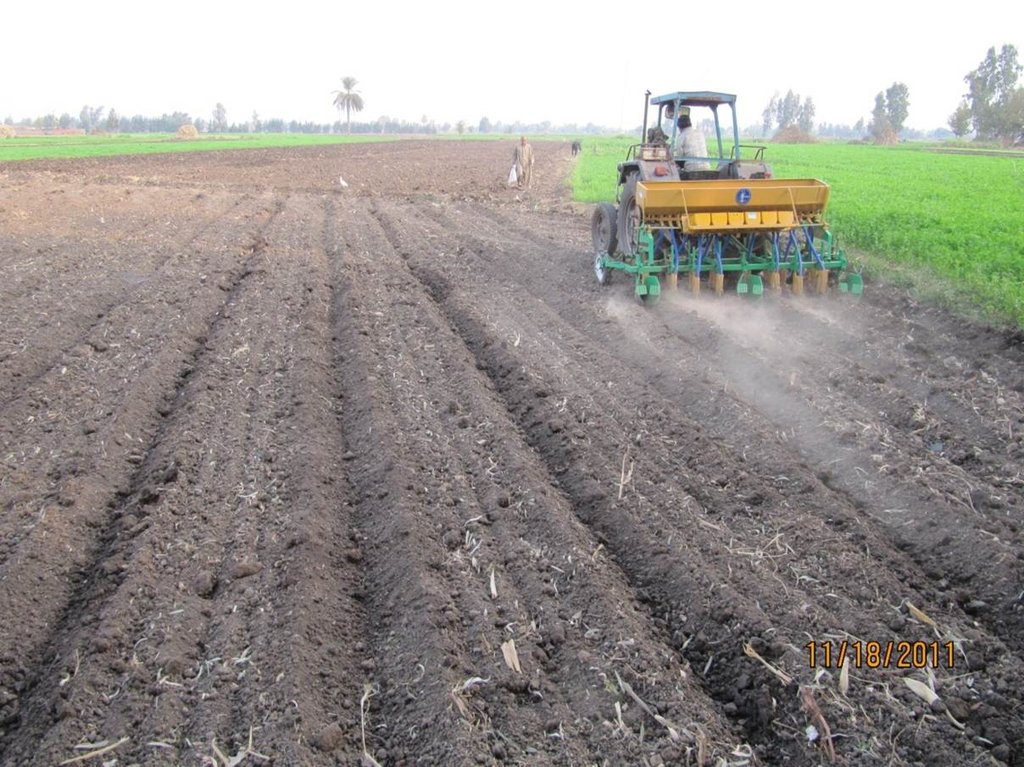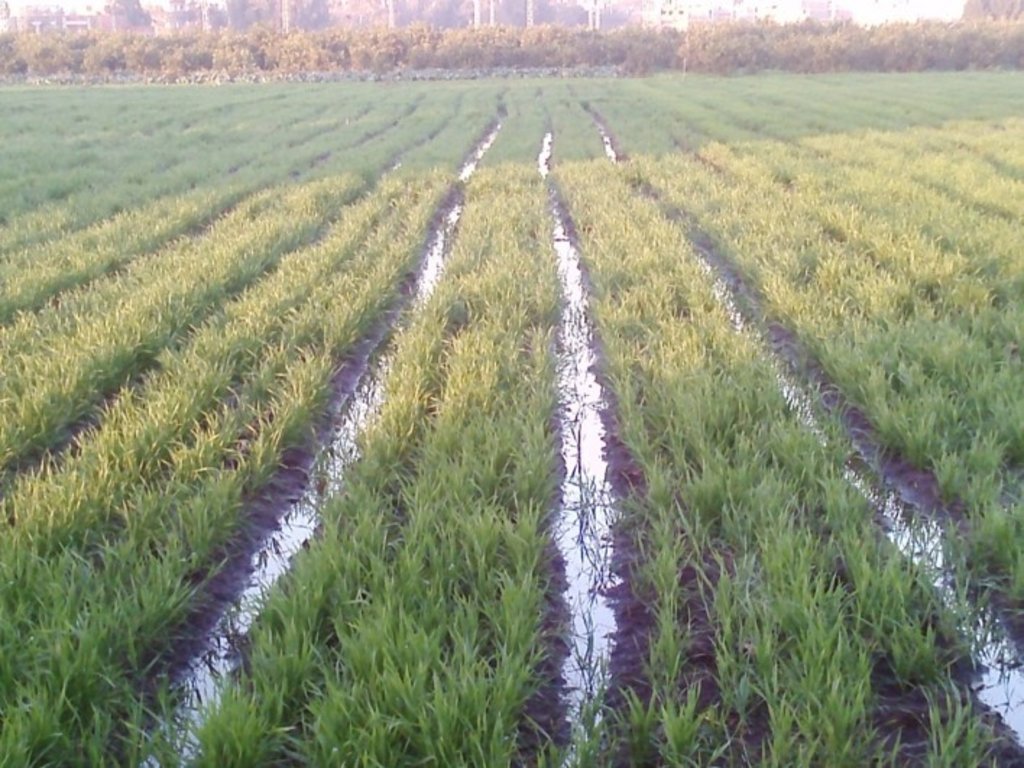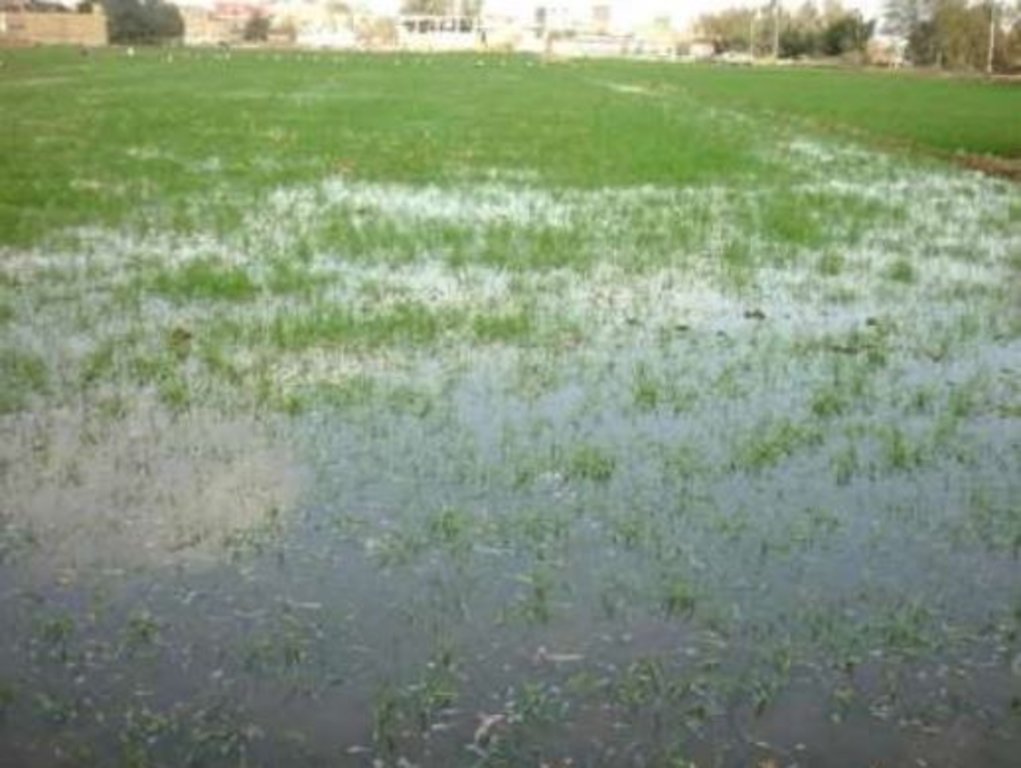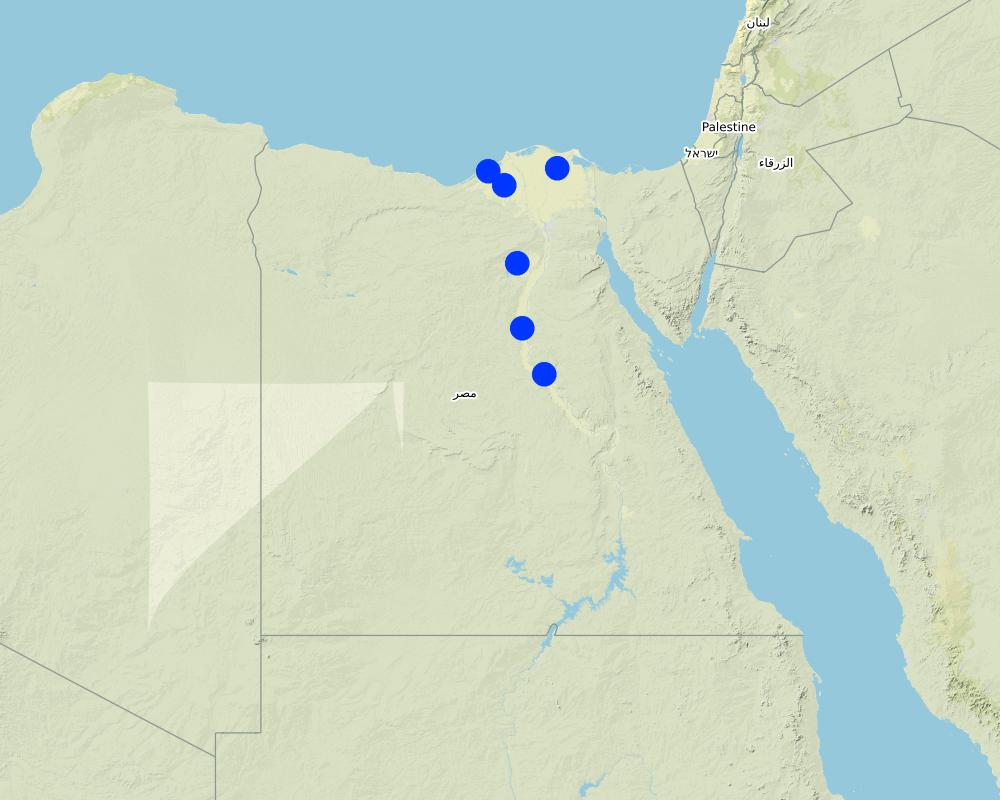Mechanized Raised Bed (MRB) Technology in a wheat based production system. [Египет]
- Создание:
- Обновить:
- Составитель: Joren Verbist
- Редактор: –
- Рецензент: Rima Mekdaschi Studer
technologies_5804 - Египет
Просмотреть разделы
Развернуть все Свернуть все1. Общая информация
1.2 Контактные данные специалистов и организаций, участвующих в описании и оценке Технологии
Ответственный (-ые) специалист (-ы)
Senior Scientist, Irrigation Water Management:
Swelam Atef
International Center of Agriculture Research in the Dry Areas (ICARDA)
Египет
Social Sciences Specialist (Water Land and Ecosystem Program):
Dessalegn Bezaiet
International Center of Agriculture Research in the Dry Areas (ICARDA)
Иордания
Название проекта, содействовавшего документированию/оценке Технологии (если применимо)
ICARDA Institutional Knowledge Management InitiativeНазвание организации (-ий), содействовавших документированию/оценке Технологии (если применимо)
International Center for Agricultural Research in the Dry Areas (ICARDA) - Ливан1.3 Условия, регламентирующие использование данных, собранных ВОКАТ
Составитель и ответственный(-ые) специалист(-ы) согласны с условиями, регламентирующими использование собранных ВОКАТ данных:
Да
1.4 Декларация по устойчивости описываемой Технологии
Вызывает ли описанная здесь Технология проблемы деградации земель настолько, что ее нельзя назвать природосберегающей?
Нет
2. Описание Технологии УЗП
2.1 Краткое описание Технологии
Определение Технологии:
Mechanized Raised Beds (MRB)-technology improves livelihoods because raised beds lead to significantly reduced costs (30% less water, 20-40% less nitrogen fertilizer) and higher wheat yields increased by 20-30%. MRB-technology helps to do more with less.
2.2 Подробное описание Технологии
Описание:
Mechanized Raised Beds (MRB)-technology has been applied by the International Centre of Agriculture Research in Dryland Areas (ICARDA) and national partners in Egypt. Egypt is a water scarce country and 95% of its water comes from beyond its borders. In addition, Egypt is highly dependent on the import of wheat, 50% of the wheat demand is met by import.
In Egypt, water scarcity and mediocre yield are two issues that keep the majority of people working in the agricultural sector in poverty. Water is scarce as the annual precipitation is less than 250mm leading to most farming to be irrigated. The water comes from the Nile river. However, available irrigation water per farmer is rather low due to population growth. Thus, due to clay soil and the use of flood irrigation, water logging and uneven water distribution over the field lead to salinization of the soil, harming the farmer's yields. Furthermore, the latter is caused by the lack of water, insufficient use of fertilizers and the use of relatively low-quality seeds. In particular, fertilizers are expensive leading to an insufficient and poor application of fertilizers.
In effect, the core objective of MRB-technology package is to fit within this context and realize more output with less input, consequently improving involved livelihoods. Indeed, MRB improves farmers' resilience with increased water and nutrient efficiency. The adopters of MRB receive benefits from direct effects such as improvement in their livelihoods, a decreased workload, increased yields and more efficient use of resources (water, fertilizer and seeds).
The first stage research and designing of MRB-technology was done in 2003. Introductions and pilots of the technology were designed together with regular farmers in the Nile Delta-area, from 2010 until 2013. In 2015, MRB-technology was proven beneficial permitting out-scaling. Thanks to the shown potential of MRB-technology and Egypt's reliance on foreign countries for water and wheat, that MRB-technology has become a strong component of Egypt's national wheat campaign. The Egyptian Government aims to cultivate 2 million acres of wheat under MRB-technology, by 2022.
MRB-technology raises the seedbed simultaneously seeding wheat, consequently creating furrows, of which the length depend on the dimensions of the farm- field. The inter- furrow spacing and the width depends on the type of crop planted and on the soil type. The field/terrain may not exceed a slope of 5%. This allows water to infiltrate, reach the end of the furrow and for safe run-off, preventing water-logging. So, to implement MRB-technology, the field might be levelled prior to implementation, but this is often not the case as MRB is designed to local conditions, and most fields already have a slope of less than 5%. The practice of the machine requires a loose soil, so it is required that the field is ploughed prior to seeding, and therefore MRB is not seen as a type of ploughing. If the field preparation is done, a MRB-machine can start seeding and raising the seedbed. Specific characteristics for MRB-technology with respect to conventional seeding, is that seeding and raising seedbeds are done simultaneously. Raising seedbeds mechanically saves 80% of the workload with respect to manually raising seedbeds. The after-harvest practice depends on the farmer preference, as some farmers prefer letting the stubble grazed, while others clear the field. The after-harvest practices are thus independent with respect to MRB.
In addition, to complement the Mechanized Raised Bed, High Quality Seeds are offered. These are beneficial as they yield higher than the regular wheat seeds. Nevertheless, the machine can also be practiced with regular wheat seeds, if the high-quality seeds are found too expensive by the farmer. The High Quality Sees are hybrid, and need to be replaced after three years to ensure high quality.
The technology has significant positive impacts for local farmers as applied water is saved by 25%, water pumping costs decreased by 25%, seed rate reduced by 50%, farming costs decreased by 30%, fertilizer use efficiency increased by 30%, and crop yield increased by 15-30% with respect to conventional farming. On overall, it is estimated that farming under MRB is about 1/3 of the cost with respect to conventional farming. Manually raising seedbeds was considered too expensive due to the required amount of labour. Thus, regular flood irrigation was practiced. Practically, this results in full surface flooding of the field. This has significantly higher evaporation hence increasing salinization, as opposed to furrow irrigation through raised seedbeds. Also, because water is well distributed over the field due to the furrows (reducing water stress and water logging), there is less leaching of the nutrient hence increased nutrient-efficiency. The raised seedbeds allow excess water, in case of a heavy rainfall event or over-irrigating, to safely run-off. These features of better water disposal and reduced evaporation makes MRB-technology well suited with respect to climate change, which leads to more concentrated rainfall events and increased temperature hence increased evaporation. In addition, as MRB prevents e.g. waterlogging it prevents land degradation (e.g. salinization).
Therefore, livelihoods of farmers who have adopted this technology have been greatly improved. Farmers who have adopted MRB, agree that MRB is affordable, easy to apply, improves production and is cost saving. Furthermore, since this technology increases irrigation efficiency , it can mitigate existing upstream-downstream issues in terms of availability, as there is more available irrigation water. Also, as MRB-technology is currently out scaled, it creates employment opportunities since MRB-machines are locally produced from scratch.
2.3 Фотографии, иллюстрирующие Технологию
2.4 Видеоматериалы, иллюстрирующие Технологию
Комментарий, краткое описание:
https://www.youtube.com/watch?v=5SW_Hf5AM3Y
Автор съемки:
ICARDA
2.5 Страна/ регион/ места, где применяется Технология, информация о которых собрана в данной Анкете
Страна:
Египет
Административная единица (Район/Область):
Sharkia, Dakahlia, Beheira, Fayoum, Minya and Asuit
Охарактеризуйте пространственное распространение Технологии :
- равномерно-однородное применение на определенной площади
Если точная область неизвестна, укажите приблизительную площадь:
- 1-10 км2
Технология применяется на ООПТ?
Нет
Map
×2.6 Сколько лет применяется данная Технология
Год начала реализации:
2003
2.7 Внедрение Технологии
Укажите, как именно Технология УЗП была внедрена:
- в качестве научного/ полевого эксперимента
- через проекты/ внешнее вмешательство
3. Классификация Технологии УЗП
3.1 Основные цели и задачи реализации Технологии
- повышение производства
- снижение или предотвращение деградации земель, восстановление нарушенных земель
- адаптация к изменению климата / экстремальным погодным явлениям и их последствиям
- создание благоприятных экономических условий
- создание благоприятных социальных условий
3.2 Текущий(-ие) тип(-ы) землепользования на территории, где применяется Технология
Комбинированное землепользование в пределах одной и той же земельной единицы:
Нет

Пахотные угодья и плантации
- Однолетние культуры
Ежегодный урожай - Уточните культуры:
- зерновые культуры - пшеница (озимая)
Число урожаев за год:
- 1
Применяются ли посевы в междурядьях?
Нет
Применяется ли севооборот?
Нет
3.3 Изменилось ли использование земель в связи с внедрением Технологии?
Изменилось ли использование земель в связи с внедрением Технологии?
- Нет (см. пункт 3.4)
3.4 Водоснабжение
Обеспеченность водой участков, где реализуется Технология :
- полное орошение
Пояснения:
The farms are irrigated from water that comes from the Nile river.
3.5 Категория УЗП, к которой относится Технология
- улучшение сортов растений/ пород животных
- Управление орошением (включая водоснабжение и дренаж)
3.6 Мероприятия УЗП, выполняемые в рамках Технологии

Агрономические мероприятия
- A3: Поверхностная обработка почв
- A5: Семенное хозяйство, селекция, применение улучшенных сортов

инженерные мероприятия
- И3: Ступенчатые канавы (арыки), каналы, водотоки
Пояснения:
Ploughing is required to allow for raising seedbeds mechanically. Nevertheless, ploughing was also done in conventional farming. As seedbeds are raised whenever wheat is sown, this is recurrent so ploughing is as well.
3.7 Основные проблемы деградации земель, на решение которых направлена Технология

ухудшение химических свойств почв
- Хс: засоление/ подщелачивание

ухудшение физических свойств почв
- Фз: заболачивание

биологическая деградация
- Бк: сокращение количества биомассы

деградация водных ресурсов
- Ва: почвенная засуха
Пояснения:
Due to degradation the biomass production decrease. MRB-technology increase safe water disposal and decreased evaporation. This results in the prevention of water logging and a decrease in the rate of salinization and aridfication.
3.8 Предотвращение и снижение деградации земель, или восстановление нарушенных земель
Укажите цель Технологии по отношению к деградации земель :
- предотвращение деградации земель
4. Технические характеристики, мероприятия по практической реализации, вложения и стоимость
4.1 Технический рисунок, иллюстрирующий Технологию
Спецификация (пояснения к техническому рисунку):
Firstly, prior to Mechanized Raised Seedbed (MRB)-implementation the field is prepared. This consist of two-way ploughing. This makes the soil sufficiently loose, to enable the practice of MRB i.e. construction of the raised seedbeds. Also, for successful implementation of the MRB, the field should have a slope of less than 5%.
Secondly, the raised bed seeder is pulled by a tractor and raises the seed bed while seeding wheat, hence Mechanized Raised Seedbed technology. The width of the furrow (A) is 35 -45 cm, this is affected by the related soil texture. The width of the raised seedbed (B) is 100-130 cm, also dependent on the soil texture. Between
seed rows (C) there is a space of 14 cm.This inter-row spacing of the crops relates to the type of crop seeded. The furrow has a depth (D) of 35-45 cm. However, after the first irrigation event the depth could be reduced to 25 cm, due to the influx of loose soil. This is not a problem for the current growing season.
This technical drawing is based on the most common conditions where MRB is implemented. These are that the crop is winter wheat, the soil texture is mostly clay and the system is watered through irrigation coming from the Nile river, rather than rain-fed. If MRB is used under different circumstances, the dimension would change as well.
Lastly, once these above-mentioned steps are successfully done, the agricultural practices do not differ from the previous/traditional method. After harvest, prior to the new season, the raised seedbed structures are still well in shape. This means that after some small reshaping, the raised seedbeds can be used for cultivation again, without using MRB and/or the previously mentioned field preparation. This reshaping is done by cleaning/digging out the furrows. Additionally, this reduces the consequences of compaction by heavy machinery, such as the tractor. As these heavy machinery are used less frequently.
Автор:
Joren Verbist (Drawing: Atef Swelam)
Дата:
30/09/2020
4.2 Общая информация по необходимым вложениям и стоимости
Уточните, как рассчитывались затраты и вложения:
- на площадь, где применяется Технология
Укажите размер и единицу площади:
1 acre
Если вы используете местные системы измерения, укажите коэффициент пересчета на один гектар (например, 1 га = 2,47 акров): 1 га =:
2.47 acres
Укажите денежные единицы, использованные для подсчета затрат:
- Доллары США
Укажите среднюю дневную заработную плату наемных работников:
6.31
4.3 Мероприятия, необходимые для начала реализации
| Деятельность | Время (сессия) | |
|---|---|---|
| 1. | Purchase MRB |
4.4 Вложения и затраты, необходимые для начала реализации
| Опишите затраты | Единица | Количество | Затраты на единицу | Общая стоимость на единицу | % затрат, оплаченных землепользователями | |
|---|---|---|---|---|---|---|
| Оборудование | MRB-Machine | Machine | 1,0 | 6000,0 | 6000,0 | 100,0 |
| Общая стоимость запуска Технологии | 6000,0 | |||||
| Общие затраты на создание Технологии в долларах США | 6000,0 | |||||
Пояснения:
The total costs per acre are estimated to be 44 USD to 64 USD for solely a MRB-machine, so the costs of the High Yield Seeds are excluded.
The purchase of a MRB-machine is commonly done by a community (such as a village). Therefore the realistic costs per farmer of the machine are rather low, as well as the cost per area. The tractor which is used to pull a MRB-machine is the same as has been used before the adoption of a MRB, so this is not an additional cost
The High Yield Seeds are offered with a MRB-machine, but a MRB-machine is build that it can use other seeds as well.
4.5 Поддержание/ текущее обслуживание
| Деятельность | Сроки/ повторяемость проведения | |
|---|---|---|
| 1. | Ploughing | Prior to seeding |
| 2. | Levelling (if needed) | Prior to seeding |
| 3. | Seeding/Raising seedbeds (i.e. use of MRB) | November |
| 4. | Irrigation Event (300-400m3) | Once in every 25-30 days |
| 5. | Fertilizer Application | Establishment Stage (November) |
| 6. | Fertilizer Application | Flowering Stage (March-May) |
| 7. | Fertilizer Application | Grain Filling Stage (June-July) |
| 8. | Harvesting | April |
| 9. | Purchase new High Yield Seeds | Once in the 3 years |
Пояснения:
MRB-machines are produced by local manufactures. This means that repairs could be done relatively cheap and on time.
The cleaning of the furrows can be done by the farmers self. Therefore, it is not a significant cost.
4.6 Стоимость поддержания/ текущего обслуживания ( в год)
| Опишите затраты | Единица | Количество | Затраты на единицу | Общая стоимость на единицу | % затрат, оплаченных землепользователями | |
|---|---|---|---|---|---|---|
| Оплата труда | Pesticide and herbicide application | Person-Day | 2,0 | 6,0 | 12,0 | 100,0 |
| Оплата труда | Field Preparation and Raising Seedbeds | Person-Day | 2,0 | 100,0 | ||
| Оплата труда | Fertilizer Application | Person-Day | 1,0 | 7,0 | 7,0 | 100,0 |
| Оплата труда | Irrigation Management | Person-Day | 5,0 | 7,0 | 35,0 | 100,0 |
| Оборудование | Combine (harvesting) | Machine Day | 1,0 | 64,0 | 64,0 | 100,0 |
| Оборудование | MRB | Machine-Day | 1,0 | 10,0 | 10,0 | 100,0 |
| Оборудование | Tractor (Raising Seedbed) | Machine-Day | 1,0 | 17,0 | 17,0 | 100,0 |
| Оборудование | Sprayer | Machine-Day | 1,0 | 20,0 | 20,0 | 100,0 |
| Оборудование | Plough | Machine-Day | 1,0 | 32,0 | 32,0 | 100,0 |
| Оборудование | Tractor (Field Preparation) | Machine-Day | 1,0 | 32,0 | 32,0 | 100,0 |
| Посадочный материал | High Yield Seeds | Kilogram | 45,0 | 0,6 | 27,0 | 100,0 |
| Удобрения и ядохимикаты | Fertilizer | Kilogram | 150,0 | 0,26 | 39,0 | 100,0 |
| Удобрения и ядохимикаты | Herbicide | Kilogram | 1,0 | 9,5 | 9,5 | 100,0 |
| Удобрения и ядохимикаты | Pesticide | Kilogram | 2,0 | 7,0 | 14,0 | 100,0 |
| Строительные материалы | Water (Irrigation Event) | 350m^3 | 20,0 | 8,0 | 160,0 | 100,0 |
| Другие | Harvesting | Person-Day | 5,0 | 7,0 | 35,0 | 100,0 |
| Другие | Maintenance Raised Seedbed | Person-Day | 8,0 | 7,0 | 56,0 | 100,0 |
| Общая стоимость поддержания Технологии | 569,5 | |||||
| Общие затраты на поддержание Технологии в долларах США | 569,5 | |||||
Пояснения:
The pumping cost is 25% less with respect to the conventional flood irrigation.
4.7 Наиболее значимые факторы, влияющие на стоимость затрат
Опишите наиболее значимые факторы, влияющие на стоимость затрат:
The most impacting cost factor is the purchase of a MRB-machine. Whereas, the High Yield Seeds are also significant, but the increased yield justifies this. In addition, farmers could also choose to use different seeds. Additionally, the High Yield Seeds are hybrid and can be reproduced for three years on the farm.
5. Природные и социально-экономические условия
5.1 Климат
Среднегодовое количество осадков
- < 250 мм
- 251-500 мм
- 501-750 мм
- 751-1000 мм
- 1001-1500 мм
- 1501-2000 мм
- 2001-3000 мм
- 3001-4000 мм
- > 4000 мм
Пояснения/ комментарии по осадкам:
The annual rainfall varies between 20mm and 200mm
Egypt is characterized as a hot desert climate (Köppen climate classification BWh). The hot season is from May to October. While the cool season is opposite, from October to May.
Агроклиматическая зона
- полузасушливая
- засушливая
Egypt is characterized as a hot desert climate (Köppen climate classification BWh). The hot season is from May to October. While the cool season is oppesite, from October to May.
5.2 Рельеф
Склоны (преобладающие):
- пологие (0-2%)
- покатые (3-5%)
- покато-крутые (6-10%)
- крутые (11-15%)
- очень крутые (16-30%)
- чрезвычайно крутые (31-60%)
- обрывистые (>60%)
Формы рельефа:
- плато/ равнины
- гребни хребтов/холмов
- склоны гор
- склоны холмов
- подножья
- днища долин
Зона высотной поясности:
- 0-100 м над уровнем моря
- 101-500 м н.у.м.
- 501-1000 м н.у.м.
- 1001-1500 м н.у.м.
- 1501-2000 м н.у.м.
- 2001-2500 м н.у.м.
- 2501-3000 м н.у.м.
- 3001-4000 м н.у.м.
- > 4 тыс. м н.у.м.
Укажите, приурочено ли применение Технологии к специфическим условиям:
- в условиях выпуклого рельефа
5.3 Почвы
Средняя мощность почв:
- поверхностные (0-20 см)
- неглубокие (21-50 см)
- умеренно глубокие (51-80 см)
- глубокие (81-120 см)
- очень глубокие (> 120 см)
Гранулометрический состав (верхнего горизонта):
- средние фракции (суглинистый, супесчаный)
- тонкодисперсный/ тяжёлый (глинистый)
Гранулометрический состав (на глубине более 20 см):
- средние фракции (суглинистый, супесчаный)
- тонкодисперсный/ тяжёлый (глинистый)
Содержание органического вещества в верхнем горизонте:
- среднее (1-3%)
- низкое (< 1%)
5.4 Доступность и качество воды
Уровень грунтовых вод:
< 5 м
Доступность поверхностных вод:
хорошая
Качество воды (без обработки):
питьевая вода плохого качества (необходима обработка)
Качество воды относится к:
поверхностные воды
Является ли солёность воды проблемой?
Да
Происходят ли периодические затопления территории?
Да
Регулярность:
эпизодически
5.5 Биоразнообразие
Видовое разнообразие:
- низкое
Разнообразие местообитаний:
- низкое
5.6 Характеристика землепользователей, применяющих Технологию
Осёдлый или кочевой:
- Осёдлый
Рыночная ориентация производства:
- смешанный (натуральный / коммерческий)
Доходы из других источников:
- 10-50% всех доходов
Относительный уровень достатка:
- плохой
Индивидуальное или коллективное хозяйство:
- группа/ община
Уровень механизации:
- механизировано/ есть автотранспорт
Пол:
- женщины
- мужчины
Возраст землепользователей:
- средний возраст
- пожилой
5.7 Средняя площадь земель, используемых землепользователями с применением Технологии
- < 0,5 га
- 0,5-1 га
- 1-2 га
- 2-5 га
- 5-15 га
- 15-50 га
- 50-100 га
- 100-500 га
- 500-1000 га
- 1000-10000 га
- > 10000 га
Считается ли это мелким, средним или крупным хозяйством (по местным масштабам)?
- мелкое
Пояснения:
However, it is hard to generalize, since the MRB has been used on such a scale, including many different farms and sizes.
5.8 Собственность на землю, права на земле- и водопользование
Землевладелец:
- индивидуальная, оформленная в собственность
Право землепользования:
- индивидуальное
Право водопользования:
- индивидуальное
Права на землепользование основаны на традиционной правовой системе?
Да
Поясните:
Land use right are formed by Islamic influences as well as colonial influences. The are different status such as private ownership and open acces.
5.9 Доступ к базовым услугам и инфраструктуре
медицинское обслуживание:
- плохой
- средний
- хорошая
образование:
- плохой
- средний
- хорошая
технические консультации:
- плохой
- средний
- хорошая
занятость (вне хозяйства):
- плохой
- средний
- хорошая
рынки:
- плохой
- средний
- хорошая
электроснабжение:
- плохой
- средний
- хорошая
транспорт и дорожная сеть:
- плохой
- средний
- хорошая
водоснабжение и канализация:
- плохой
- средний
- хорошая
финансовые услуги:
- плохой
- средний
- хорошая
Пояснения:
In the Nile Delta, the MRB-technology is used on very large area with many different farmers, therefore it is hard to generalize the aspects of the Health and Education since these are highly related to the income of a farm.
6. Воздействия и заключительные положения
6.1 Влияние Технологии УЗП в пределах территории ее применения
Социально-экономическое воздействие
Продуктивность
производство сельскозяйственных культур
Количество после применения УЗП:
+20%-30%
Комментарий/ пояснения:
The yield is increased due to reduced water stress and because of the use of improved wheat varieties.
качество урожая
Комментарий/ пояснения:
The quality of the crops is increased due to reduced water stress.
риск потери продуктивности
Комментарий/ пояснения:
This decrease as the impact of intense rainfall events is reduced as consequence of safe disposal through furrows.
Доступность и качество воды
потребность в оросительной воде
Комментарий/ пояснения:
The demand of irrigation water is reduced because the efficiency of it is increased i.e. water is applied more effectively.
Доходы и затраты
сельскохозяйственные издержки
Комментарий/ пояснения:
50% less seed rate. 20% higher fertilizer efficiency.
доходы хозяйства
Комментарий/ пояснения:
Because of higher yield and less input
объем работ
Комментарий/ пояснения:
The workload was reduced by 80% for mechanized seedbed raising (MRB) compared to manual seedbed raising.
Социальное и культурное воздействие
смягчение конфликтов
Комментарий/ пояснения:
Because the irrigation efficiency is increased, there is relatively more available irrigation water. This leads to a mitigating effect on upstream/downstream tensions
Экологическое воздействие
Водный цикл/ поверхностный сток
поверхностный сток
Комментарий/ пояснения:
Run-off occurs more easily with respect to traditional practices. This is positive, since this prevent water-logging.
водный дренаж
испарение
Комментарий/ пояснения:
Compared to previous border/field irrigation, the water infiltrates easier, and is concentrated more. This leads to a decrease in evaporation.
Почвы
влажность почв
круговорот/ восполнение питательных веществ
Комментарий/ пояснения:
Due to better infiltration, the fertilizers are used more efficient.
засоленность
Комментарий/ пояснения:
Salinity is decreased because evaporation and water logging is reduced.
Биоразнообразие: растительность, животный мир
биомасса/ содержание углерода в надземной биомассе
Климат и снижение риска стихийных бедствий
последствия наводнений
Комментарий/ пояснения:
The impact of a flood is reduced because the excess water is able to safely run-off through the established furrows.
6.2 Влияние Технологии за пределами территории ее применения
подтопление ниже по течению
Комментарий/ пояснения:
Due to the increased irrigation water efficiency, there is relatively more water available to desirably flood (border/surface irrigation/ MRB) farm fields downstream
6.3 Подверженность и чувствительность Технологии УЗП к постепенным изменениям климата и экстремальным погодным явлениям/ стихийным бедствиям, связанным с изменением климата (в понимании землепользователей)
Постепенное изменение климата
Постепенное изменение климата
| Сезон | увеличение или уменьшение | Насколько успешно Технология справляется с этим? | |
|---|---|---|---|
| среднегодовые температуры | увеличилось | умеренно | |
| среднегодовое количество осадков | снизилось | хорошо |
Экстремальные явления, связанные с изменением климата (стихийные бедствия)
Гидрологические стихийные бедствия
| Насколько успешно Технология справляется с этим? | |
|---|---|
| регулярные наводнения (выход рек из берегов) | хорошо |
| паводки | хорошо |
6.4 Анализ эффективности затрат
Насколько получаемый результат сопоставим с первоначальными вложениями (с точки зрения землепользователей)?
Эффективность затрат в краткосрочной перспективе:
очень позитивное
Эффективность затрат в долгосрочной перспективе:
очень позитивное
Насколько получаемый результат сопоставим с текущими расходами по поддержанию технологии (с точки зрения землепользователей)?
Эффективность затрат в краткосрочной перспективе:
очень позитивное
Эффективность затрат в долгосрочной перспективе:
позитивное
Пояснения:
In the short-term investments are weighing relatively more than in the long term with respect to the benefits. However, on the overall, the MRB-technology offers more efficient use of resources, coming down to achieving more output with less input. Thus, highly improving the involved livelihoods.
In the long term the benefits are less positive with respect to maintenance. This is due to the aging of machinery. MRB-machines are estimated to have a life span of 12 years.
6.5 Внедрение Технологии
- > 50%
Среди применяющих Технологию землепользователей, какова доля лиц, применяющих её по собственной инициативе, т.е. без какого-либо материального стимулирования со стороны?
- 91-100%
6.6 Адаптация
Была ли Технология УЗП изменена в недавнее время с целью адаптации к меняющимся условиям среды?
Да
другое (поясните):
Local Conditions
Укажите, что именно изменилось в Технологии (дизайн, используемые материалы или виды растений/животных и т.д.):
These adaptations are initiated because of the successes of the MRB, so currently MRB-technology is modified to be used with other crops (e.g. Faba Bean), other soil textures and for rain-fed areas.
6.7 Сильные стороны/ преимущества/ возможности Технологии
| Сильные стороны/ преимущества/ возможности по мнению землепользователей |
|---|
| MRB significantly contributes to the prosperity of the farmers who have adopted this technology. For farmers, the major advantage of MRB (High Quality Seeds plus the raised seedbeds) is the increased yield. |
| The adoption of the technology leads eventually to less leaching hence higher fertilizer efficiency. This is also highly valued by the farmers as this translates into less expenses. This advantage of the MRB combined to the increased yield, results in the realization of more income with less expenses, and thus a higher net income. |
| In Egypt climate change is visibly present and water does not seem to be abundant anymore, the farmers do have increasingly attention for the value of water. MRB increases the irrigation efficiency, therefore this is also observed as a great advantage of MRB. |
| Сильные стороны/ преимущества/ возможности по мнению составителя или других ключевых специалистов |
|---|
| The increased yield is of great advantage not only for the improved situation of the involved livelihood, but also on national level. Namely, because more yield means less import of food from other countries. This makes Egypt more self-sufficient, and less dependent on other countries. This is particularly relevant with respect to the significant population growth of Egypt. |
| The increased water availability, because of higher irrigation efficiency is important on a national level. This is certainly important, with respect to trend of increasing the power generation by water (hydraulic power plants), in upstream areas of Egypt. |
| MRB-technology has led to a local industry. This industry is the manufacturing of MRB-machines. This is on broader level beneficial, because it creates local employment, efficient supply chain, easy and fast access to technical knowledge and gives Egypt an independent position. |
| MRB improves soil health because salinization is reduced as water is less evaporated and logged. |
6.8 Слабые стороны/ недостатки/ риски Технологии и пути их преодоления
| Слабые стороны/ недостатки/ риски по мнению землепользователей | Возможные пути их преодоления/снижения? |
|---|---|
| A current risk of MRB is that many farmers are convinced of the beneficial application of the MRB, which means that there is higher demand. Therefore, there is currently not a sufficient number of MRB-machines. In practice this means that some farmers are not able to use MRB-machine during the essential seeding period. This is possibly followed by tensions between users since the technology is often purchased as communities. Land users found this a weakness of the technology. | This is to overcome if public and private sectors invest in the manufacturing of MRB. This would lead to an increased supply of machine, thus eliminating the deficit of machines. |
| The cost of the High Yield Seeds is a weakness of MRB-technology. This is because the costs of the seeds are quite high and they contribute significantly to the increased yields. So without the seeds, MRB-technology does not reach its full potential. Farmers dislike the costs of these seeds and the yearly purchasing. | There are investments needed and plans to improve the production of these seeds. The increased supply would lead to reduced costs. |
| Слабые стороны/ недостатки/ риски по мнению составителя или ответственных специалистов | Возможные пути их преодоления/снижения? |
|---|---|
| The risk of tensions that are a consequence of the limited availability of the MRB's. | This could be overcome by increasing the production. However, better social cooperation could reduce the tensions between and within communities as well. |
| The costs of the High Yield Seeds. This is a weakness, because MRB-technology is significantly improved by these seeds, realizing its full potential. | There are investments needed and plans to improve the production of these seeds. This would lead to reduced costs. However, alternatively, other seeds can be used. |
7. Справочные материалы и ссылки
7.1 Методы сбора/ источники информации
- опросы специалистов/экспертов по УЗП
- данные, собранные из отчетов и достоверных документов
7.2 Ссылки на опубликованные материалы
Название, автор, год публикации, ISBN:
Atef Swelam and Y. Atta, (2012) Improve Water Saving and Water Productivity by New Approach of Farm Management under Surface Irrigation. Mi. J. Ag. Eng., 29 (2):745-762.
Где опубликовано? Стоимость?
https://hdl.handle.net/20.500.11766/12227
7.3 Ссылки на соответствующую онлайн-информацию
Название/ описание:
Jeffrey Alwang, Samy Sabry, Kamel Shideed, Atef Swelam and Habib Halila (2017) Economic and food security benefits associated with raised-bed wheat production in Egypt, Journal of Food Security, FOSE-D-17-00372)
Адрес в сети Интернет:
https://hdl.handle.net/20.500.11766/8228
Название/ описание:
Atef Swelam (2016) Science Impact: Raised-bed planting in Egypt: an affordable technology to rationalize water use and enhance water productivity, Issue: 6-FEB 2016, ICARDA.
Адрес в сети Интернет:
https://hdl.handle.net/20.500.11766/5900
Название/ описание:
National Wheat Campaign Report (2020), Agricultural Research Center, Ministry of Agriculture and Land Reclamation, Cairo, Egypt
Адрес в сети Интернет:
https://hdl.handle.net/20.500.11766/8228
Название/ описание:
Karrou, M., T. Oweis, B. Benli and A. Swelam (2012). Improving Water and Land Productivities in Irrigated Systems, ICARDA, ISBN:92-9127-259-0.
Адрес в сети Интернет:
https://hdl.handle.net/20.500.11766/8825
Название/ описание:
Atef Swelam. (16/11/2016). Egypt farmers save water with new irrigation method. New York, United States: The Associated Press (Executive Producer)
Адрес в сети Интернет:
https://hdl.handle.net/20.500.11766/5757
Название/ описание:
Atef Swelam. (31/7/2020). On-farm irigation improvement Infographic Map. Beirut, Lebanon: International Center for Agricultural Research in the Dry Areas (ICARDA).
Адрес в сети Интернет:
https://hdl.handle.net/20.500.11766/11823
Название/ описание:
Secretariat FAO. (1/4/2018). Mechanized raised-bed irrigation: Production package. Italy: Food and Agriculture Organization of the United Nations (FAO).
Адрес в сети Интернет:
https://hdl.handle.net/20.500.11766/11114
Название/ описание:
Swelam, A. ICARDA. (2019, 1 juli). Improve on Farm Irrigation [Presentation]. Slideshare.
Адрес в сети Интернет:
https://hdl.handle.net/20.500.11766/12232
Ссылки и модули
Развернуть все Свернуть всеСсылки
Нет ссылок
Модули
Нет модулей


